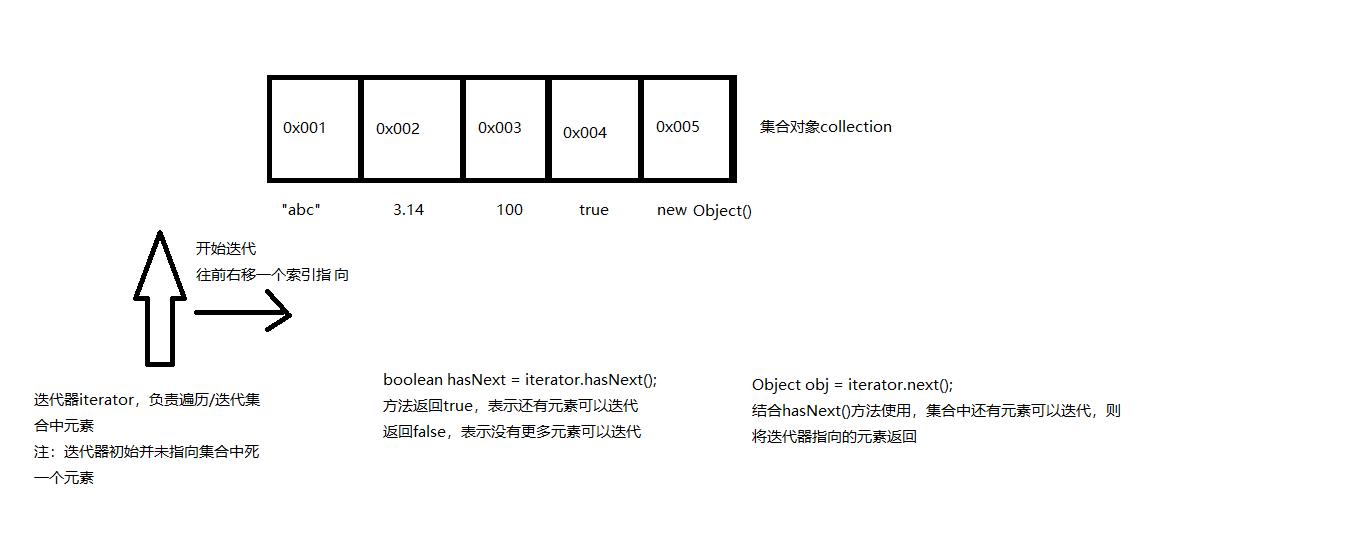Java--迭代器(Iterator)迭代原理
Posted MinggeQingchun
tags:
篇首语:本文由小常识网(cha138.com)小编为大家整理,主要介绍了Java--迭代器(Iterator)迭代原理相关的知识,希望对你有一定的参考价值。
Java中迭代器(Iterator)是一个接口,通过构造方法iterator()可以获取迭代器
public interface Iterable<T>
/**
* Returns an iterator over elements of type @code T.
*
* @return an Iterator.
*/
Iterator<T> iterator();
Collection继承自 Iterable
public interface Iterator<E>
/**
* Returns @code true if the iteration has more elements.
* (In other words, returns @code true if @link #next would
* return an element rather than throwing an exception.)
*
* @return @code true if the iteration has more elements
*/
boolean hasNext();
/**
* Returns the next element in the iteration.
*
* @return the next element in the iteration
* @throws NoSuchElementException if the iteration has no more elements
*/
E next();
1、Collection接口是其子接口,他是所有单一元素集合的父类接口
集合中不能直接存储基本数据类型,也不能存 java对象,只是存储java对象的内存地址
(1)没有使用“泛型”之前,Collection中可以存储Object的所有子类型
(2)使用了“泛型”之后,Collection中只能存储某个具体的类型。Collection中什么都能存, 只要是Object的子类型就行
2、Collection中的常用方法
(1)boolean add(Object e) 向集合中添加元素
(2)int size() 获取集合中元素的个数
(3)void clear() 清空集合
(4)boolean contains(Object o) 判断当前集合中是否包含元素o,包含返回true,不包含返回false
(5)boolean remove(Object o) 删除集合中的某个元素
(6)boolean isEmpty() 判断该集合中元素的个数是否为0
(7)Object[] toArray() 把集合转换成数组
public interface Collection<E> extends Iterable<E>
// Query Operations
int size();
boolean isEmpty();
Iterator<E> iterator();
Object[] toArray();
<T> T[] toArray(T[] a);
boolean add(E e);
boolean remove(Object o);
boolean containsAll(Collection<?> c);
boolean addAll(Collection<? extends E> c);
boolean removeAll(Collection<?> c);
void clear();
boolean equals(Object o);
int hashCode();
我们主要看一下迭代器的遍历/迭代原理,如下代码,在集合中添加元素,然后进行遍历
1、获取集合对象的迭代器对象it
Iterator it = c.iterator();
2、通过迭代器对象迭代/遍历
public class CollectionTest
public static void main(String[] args)
Collection c = new ArrayList();
c.add("abc");
c.add(3.14);
c.add(100);
c.add(true);
c.add(new Object());
/**
* 对集合Collection进行遍历/迭代
*
* boolean hasNaext() 集合中元素是否可以迭代,可以返回true
* Object next() 返回下一个元素
* */
//1、获取集合对象的迭代器对象it
Iterator it = c.iterator();
//2、通过迭代器对象迭代/遍历
while (it.hasNext())
Object obj = it.next();
System.out.println(obj);
画图理解如下:

注:
集合元素的remove
(1)当集合的结构发生改变时,迭代器必须重新获取,如果还是用以前老的迭代器,会出现 异常:java.util.ConcurrentModificationException
(2)在迭代集合元素的过程中,不能调用集合对象collection的remove方法,删除元素: collection.remove(o); 否则会出现异常:java.util.ConcurrentModificationException
(3)在迭代元素的过程当中,一定要使用迭代器Iterator的remove方法,删除元素, 不要使用集合自带的remove方法删除元素。
public class CollectionTest06
public static void main(String[] args)
// 创建集合
Collection c = new ArrayList();
// 注:此时获取的迭代器,指向的是那是集合中没有元素状态下的迭代器。
// 集合结构只要发生改变,迭代器必须重新获取。
// 当集合结构发生了改变,迭代器没有重新获取时,调用next()方法时:会出现异常;java.util.ConcurrentModificationException
Iterator it = c.iterator();
// 添加元素
c.add(1); // Integer类型
// 获取迭代器
//Iterator it = c.iterator();
/*while(it.hasNext())
// 编写代码时next()方法返回值类型必须是Object。
// Integer i = it.next();
Object obj = it.next();
System.out.println(obj);
*/
Collection c2 = new ArrayList();
c2.add("abc");
c2.add("def");
c2.add("xyz");
Iterator it2 = c2.iterator();
while(it2.hasNext())
Object o = it2.next();
// 删除元素
// 删除元素之后,集合的结构发生了变化,应该重新去获取迭代器
// 但是,循环下一次的时候并没有重新获取迭代器,所以会出现异常:java.util.ConcurrentModificationException
// 出异常根本原因是:集合中元素删除了,没有更新迭代器(迭代器不知道集合变化了)
//c2.remove(o); // 直接通过集合去删除元素,没有通知迭代器。(导致迭代器的快照和原集合状态不同。)
// 迭代器去删除时,会自动更新迭代器,并且更新集合(删除集合中的元素)。
it2.remove(); // 删除的一定是迭代器指向的当前元素。
System.out.println(o);
System.out.println(c2.size()); //0
以上是关于Java--迭代器(Iterator)迭代原理的主要内容,如果未能解决你的问题,请参考以下文章